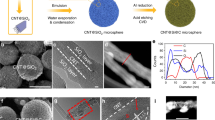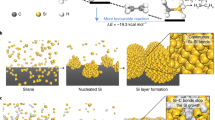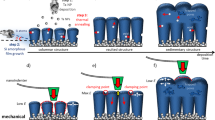Abstract
Silicon is an attractive material for anodes in energy storage devices1,2,3, because it has ten times the theoretical capacity of its state-of-the-art carbonaceous counterpart. Silicon anodes can be used both in traditional lithium-ion batteries and in more recent Li–O2 and Li–S batteries as a replacement for the dendrite-forming lithium metal anodes. The main challenges associated with silicon anodes are structural degradation and instability of the solid-electrolyte interphase caused by the large volume change (∼300%) during cycling, the occurrence of side reactions with the electrolyte, and the low volumetric capacity when the material size is reduced to a nanometre scale4,5,6,7. Here, we propose a hierarchical structured silicon anode that tackles all three of these problems. Our design is inspired by the structure of a pomegranate, where single silicon nanoparticles are encapsulated by a conductive carbon layer that leaves enough room for expansion and contraction following lithiation and delithiation. An ensemble of these hybrid nanoparticles is then encapsulated by a thicker carbon layer in micrometre-size pouches to act as an electrolyte barrier. As a result of this hierarchical arrangement, the solid-electrolyte interphase remains stable and spatially confined, resulting in superior cyclability (97% capacity retention after 1,000 cycles). In addition, the microstructures lower the electrode–electrolyte contact area, resulting in high Coulombic efficiency (99.87%) and volumetric capacity (1,270 mAh cm−3), and the cycling remains stable even when the areal capacity is increased to the level of commercial lithium-ion batteries (3.7 mAh cm−2).
This is a preview of subscription content, access via your institution
Access options
Subscribe to this journal
Receive 12 print issues and online access
$259.00 per year
only $21.58 per issue
Buy this article
- Purchase on Springer Link
- Instant access to full article PDF
Prices may be subject to local taxes which are calculated during checkout




Similar content being viewed by others
References
Armand, M. & Tarascon, J-M. Building better batteries. Nature 451, 652–657 (2008).
Arico, A. S., Bruce, P., Scrosati, B., Tarascon, J-M. & van Schalkwijk, W. Nanostructured materials for advanced energy conversion and storage devices. Nature Mater. 4, 366–377 (2005).
Bruce, P. G., Freunberger, S. A., Hardwick, L. J. & Tarascon, J-M. Li–O2 and Li–S batteries with high energy storage. Nature Mater. 11, 19–29 (2012).
Beaulieu, L. Y., Eberman, K. W., Turner, R. L., Krause, L. J. & Dahn, J. R. Colossal reversible volume changes in lithium alloys. Electrochem. Solid-State Lett. 4, A137–A140 (2001).
Obrovac, M. N. & Christensen, L. Structural changes in silicon anodes during lithium insertion/extraction. Electrochem. Solid-State Lett. 7, A93–A96 (2004).
Obrovac, M. N., Christensen, L., Le, D. B. & Dahn, J. R. Alloy design for lithium-ion battery anodes. J. Electrochem. Soc. 154, A849–A855 (2007).
Larcher, D. et al. Recent findings and prospects in the field of pure metals as negative electrodes for Li-ion batteries. J. Mater. Chem. 17, 3759–3772 (2007).
Chan, C. K. et al. High-performance lithium battery anodes using silicon nanowires. Nature Nanotech. 3, 31–35 (2008).
Wu, H. & Cui, Y. Designing nanostructured Si anodes for high energy lithium ion batteries. Nano Today 7, 414–429 (2012).
Park, M-H. et al. Silicon nanotube battery anodes. Nano Lett. 9, 3844–3847 (2009).
Magasinski, A. et al. High-performance lithium-ion anodes using a hierarchical bottom-up approach. Nature Mater. 9, 353–358 (2010).
Deshpande, R., Cheng, Y-T. & Verbrugge, M. W. Modeling diffusion-induced stress in nanowire electrode structures. J. Power Sources 195, 5081–5088 (2010).
Liu, G. et al. Polymers with tailored electronic structure for high capacity lithium battery electrodes. Adv. Mater. 23, 4679–4683 (2011).
Lee, S. W., McDowell, M. T., Berla, L. A., Nix, W. D. & Cui, Y. Fracture of crystalline silicon nanopillars during electrochemical lithium insertion. Proc. Natl Acad. Sci. USA 109, 4080–4085 (2012).
Hwang, T. H., Lee, Y. M., Kong, B-S., Seo, J-S. & Choi, J. W. Electrospun core–shell fibers for robust silicon nanoparticle-based lithium ion battery anodes. Nano Lett. 12, 802–807 (2012).
Yi, R., Dai, F., Gordin, M. L., Chen, S. & Wang, D. Micro-sized Si–C composite with interconnected nanoscale building blocks as high-performance anodes for practical application in lithium-ion batteries. Adv. Energy Mater. 3, 295–300 (2013).
Aurbach, D. Review of selected electrode–solution interactions which determine the performance of Li and Li ion batteries. J. Power Sources 89, 206–218 (2000).
Chan, C. K., Ruffo, R., Hong, S. S. & Cui, Y. Surface chemistry and morphology of the solid electrolyte interphase on silicon nanowire lithium-ion battery anodes. J. Power Sources 189, 1132–1140 (2009).
Verma, P., Maire, P. & Novák, P. A review of the features and analyses of the solid electrolyte interphase in Li-ion batteries. Electrochim. Acta 55, 6332–6341 (2010).
Wu, H. et al. Stable cycling of double-walled silicon nanotube battery anodes through solid-electrolyte interphase control. Nature Nanotech. 7, 310–315 (2012).
Liu, N. et al. A yolk-shell design for stabilized and scalable Li-ion battery alloy anodes. Nano Lett. 12, 3315–3321 (2012).
Li, X. et al. Hollow core–shell structured porous Si–C nanocomposites for Li-ion battery anodes. J. Mater. Chem. 22, 11014–11017 (2012).
Chen, S. et al. Silicon core–hollow carbon shell nanocomposites with tunable buffer voids for high capacity anodes of lithium-ion batteries. Phys. Chem. Chem. Phys. 14, 12741–12745 (2012).
Park, Y. et al. Si-encapsulating hollow carbon electrodes via electroless etching for lithium-ion batteries. Adv. Energy Mater. 3, 206–212 (2012).
Wang, B. et al. Contact-engineered and void-involved silicon/carbon nanohybrids as lithium-ion-battery anodes. Adv. Mater. 25, 3560–3565 (2013).
Cho, Y-S., Yi, G-R., Kim, S-H., Pine, D. J. & Yang, S-M. Colloidal clusters of microspheres from water-in-oil emulsions. Chem. Mater. 17, 5006–5013 (2005).
Yin, Y-X., Xin, S., Wan, L-J., Li, C-J. & Guo, Y-G. Electrospray synthesis of silicon/carbon nanoporous microspheres as improved anode materials for lithium-ion batteries. J. Phys. Chem. C 115, 14148–14154 (2011).
Jung, D. S., Hwang, T. H., Park, S. B. & Choi, J. W. Spray drying method for large-scale and high-performance silicon negative electrodes in Li-ion batteries. Nano Lett. 13, 2092–2097 (2013).
Huang, J. Y. et al. In situ observation of the electrochemical lithiation of a single SnO2 nanowire electrode. Science 330, 1515–1520 (2010).
McDowell, M. T. et al. In situ TEM of two-phase lithiation of amorphous silicon nanospheres. Nano Lett. 13, 758–764 (2013).
De Volder, M. F. L., Tawfick, S. H., Baughman, R. H. & Hart, A. J. Carbon nanotubes: present and future commercial applications. Science 339, 535–539 (2013).
Liu, N., Hu, L., McDowell, M. T., Jackson, A. & Cui, Y. Prelithiated silicon nanowires as an anode for lithium ion batteries. ACS Nano 5, 6487–6493 (2011).
Li, N. et al. Sol-gel coating of inorganic nanostructures with resorcinol-formaldehyde resin. Chem. Commun. 49, 5135–5137 (2013).
Acknowledgements
Y.C. acknowledges support from the Assistant Secretary for Energy Efficiency and Renewable Energy, Office of Vehicle Technologies of the US Department of Energy (contract no. DE-AC02-05CH11231, subcontract no. 6951379) under the Batteries for Advanced Transportation Technologies (BATT) Program. M.T.M. acknowledges the National Science Foundation Graduate Fellowship Program and the Stanford Graduate Fellowship Program. H.W.L. acknowledges the Basic Science Research Program through the National Research Foundation of Korea (NRF) funded by the Ministry of Education, Science and Technology (contract no. 2012038593). The authors thank Z. Chen for discussions, F. Wei for providing the carbon nanotubes and Croda for providing the emulsifier.
Author information
Authors and Affiliations
Contributions
N.L., Z.L. and Y.C. conceived the concept and experiments. N.L. and Z.L. carried out the synthesis and performed materials characterization and electrochemical measurements. J.Z. participated in part of the synthesis and electrochemical measurements. M.T.M. and H.W.L. conducted in situ TEM characterization. W.Z. conducted focused ion beam experiments. N.L., Z.L. and Y.C. co-wrote the paper. All authors discussed the results and commented on the manuscript.
Corresponding author
Ethics declarations
Competing interests
The authors declare no competing financial interests.
Supplementary information
Supplementary information
Supplementary Information (PDF 4350 kb)
Supplementary movie 1
Supplementary movie 1 (MOV 11563 kb)
Supplementary movie 2
Supplementary movie 2 (MOV 3031 kb)
Rights and permissions
About this article
Cite this article
Liu, N., Lu, Z., Zhao, J. et al. A pomegranate-inspired nanoscale design for large-volume-change lithium battery anodes. Nature Nanotech 9, 187–192 (2014). https://doi.org/10.1038/nnano.2014.6
Received:
Accepted:
Published:
Issue Date:
DOI: https://doi.org/10.1038/nnano.2014.6
This article is cited by
-
Progress and prospects of graphene-based materials in lithium batteries
Rare Metals (2024)
-
Electrode Conditions of Lithium-Ion Cell for Achieving High Energy Density
Korean Journal of Chemical Engineering (2024)
-
Electro-Chemo-Mechanical Modeling of Multiscale Active Materials for Next-Generation Energy Storage: Opportunities and Challenges
JOM (2024)
-
Surface-redox sodium-ion storage in anatase titanium oxide
Nature Communications (2023)
-
Encapsulating Si nanoparticles in multi-shell hollow spheres: An effective approach to boost the cyclability
Science China Materials (2023)



